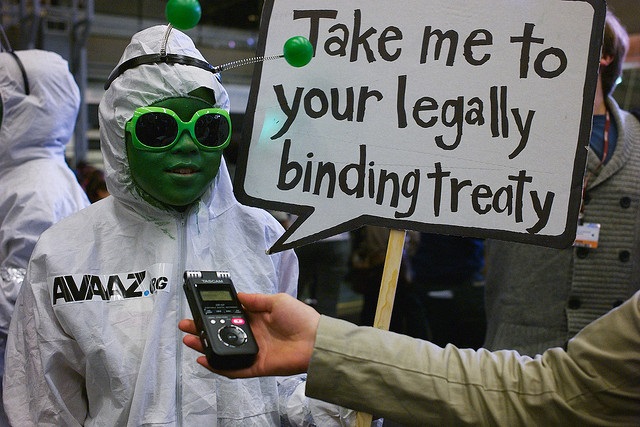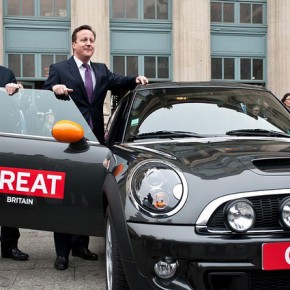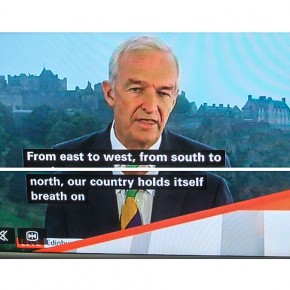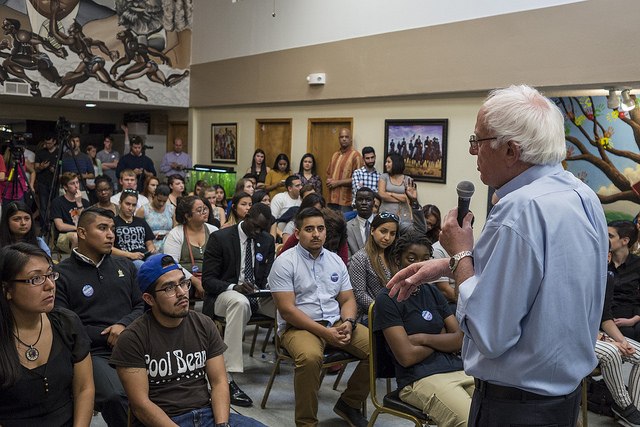I’ve never been to a protest march that advertised in the New York City subway. That spent $220,000 on posters inviting Wall Street bankers to join a march to save the planet, according to one source. That claims you can change world history in an afternoon after walking the dog and eating brunch. Welcome to the “People’s Climate March,” which took place yesterday in New York City. It was timed to take place before world leaders hold a Climate Summit at the United Nations tomorrow.
Organizers billed it as the “biggest climate change demonstration ever” with similar marches around the world. The Nation described the pre-organizing as following “a participatory, open-source model that recalls the Occupy Wall Street protests.” A leader of 350.org, one of the main organizing groups, explained, “Anyone can contribute, and many of our online organizing ‘hubs’ are led by volunteers who are often coordinating hundreds of other volunteers.”
I joined the march, as well as the Climate Convergence which started on Friday. I will also be a part of the important “Flood Wall Street” direct action that takes place today on Wall Street. I’ve had conversations with more than a dozen organizers including senior staff at the organizing groups. Many people were genuinely excited about yesterday’s demonstration. The movement is radicalizing thousands of youth. Endorsers include some labor unions and many people-of-color community organizations that normally distance themselves from environmental activism because the mainstream green movement has often done a poor job of talking about the impact on or solutions for workers and the Global South. Nonetheless, to quote Han Solo, “I’ve got a bad feeling about this.”
Environmental activist Anne Petermann and writer Quincy Saul describe how the People’s Climate March has no demands, no targets, and no enemy. Organizers admitted encouraging bankers to march was like saying Blackwater mercenaries should join an antiwar protest. There is no unity other than money. One veteran activist who was involved in Occupy Wall Street said it was made known there was plenty of money to hire her and others. There is no sense of history: decades of climate-justice activism are being erased by the sensationalist phrase “biggest climate change demonstration ever.” Investigative reporter Cory Morningstar has connected the dots between the organizing groups, 350.org and Avaaz, the global online activist outfit modeled on MoveOn.org, and institutions like the World Bank and Clinton Global Initiative. Morningstar claims the secret of Avaaz’s success is its “expertise in behavioral change.”
That is what I find most troubling. Having worked on Madison Avenue for nearly a decade, I can smell a P.R. and marketing campaign a mile away. That seems to be how the People’s Climate March was organized. According to inside sources a push early on for a Seattle-style event—organizing thousands of people to nonviolently shut down the area around the United Nations—was thwarted by paid staff with the organizing groups. One participant in the organizing meetings said, “In the beginning people were saying, ‘This is our Seattle.” But the paid staff got the politics-free Climate March. Another source said, “You wouldn’t see Avaaz promoting an Occupy-style action. The strategic decision was made to have a big march and get as many mainstream groups on board as possible.”
Nothing wrong with that. Not every tactic should be based on Occupy. But in an email about climate change that Avaaz sent out last December, which apparently raked in millions of dollars, it wrote, “It’s time for powerful, direct, non-violent action, to capture imagination, convey moral urgency, and inspire people to act. Think Occupy.” Think Occupy? Without the politics? What is happening exactly?

It seems that Avaaz found a lucrative revenue stream by warning about climate catastrophe that can only be solved with a donate button. This isn’t really a surprise. Avaaz has pioneered clickbait activism. It gets people to sign petitions about dramatic but ultimately minor issues. The operating method of Avaaz, which was established in 2007, is to create “actions” like these that generate emails for its fundraising operation. Avaaz’s business model to create products (the actions), that help it increase market share (emails), and ultimately, revenue. The actions that get the most attention are ones with the most petition signers, media coverage, and ability to generate that revenue. Social justice is turned into a product that enhances the liberal do-goodery. Avaaz profits off using internet activism and philanthropy as a release valve for people who desire genuine change, but lack the tools for building it directly. Now, it has set its sights on the climate justice movement.
To convince people to donate, it says we need Occupy-style actions. That lets people direct their desire for social change into a click of their mouses. When the moment came for assembling such a protest, though, Avaaz and 350.org blocked it. When it finally did get organized in the form of Flood Wall Street, they pushed it out of sight. If you go to the People’s Climate March website, you won’t find any mention of the Flood Wall Street action, which I fully support, but fear is being organized with too little time and resources. Nor have I seen it in an Avaaz email, nor has anyone else I’ve talked to. Bill McKibben of 350.org began promoting it this week, but that may be because there is discontent in the activist ranks about the march, which includes a number of Occupy Wall Street activists. One inside source said, “It’s a branding decision not to promote the Flood Wall Street action. These are not radical organizations.”
Branding. That’s how the climate crisis is going to be solved. We are in an era of postmodern social movements. The image is said to come first, not the ideology, and it is the branding that shapes the reality. The P.R. and marketing determines the tactics, the messaging, the organizing, and the strategy. When I asked an insider what the metrics for success would be, the insider told me that it would be measured by media coverage and long-term polling about public opinion. I was dumbfounded. Those are the exact same tools we would use in huge marketing campaigns. First we would estimate and tally media “impressions” across all digital, print, outdoor, and so on. Then a few months down the road we would conduct surveys to see if we changed the consumer’s opinion of the brand, their favorability, the qualities they associated with it, the likelihood they would try. Avaaz is doing the same thing.
That is how we should read Avaaz’s branding about changing world history. The more dramatic the language, the better the response. It’s like the supermarket. The bags and boxes don’t say, “Not bad,” or “kinda tasty.” They say “the cheesiest,” “the most delicious,” “an avalanche of flavor,” “utterly irresistible.” That’s why climate change polls so well for Avaaz. You see the same overblown rhetoric being used for the People’s Climate March: It’s the “biggest ever.” There is “unprecedented collaboration” with more than 1,400 “partner” groups in New York City. Everything comes down to this one day with the “future on the line and the whole world watching, we’ll take a stand to bend the course of history.”

Whether this can have a positive effect is a different question, and it’s why I encourage everyone to keep participating. The future is unknowable, after all. But left to their own devices, the organizers will lead the movement into the graveyard of the Democratic Party, just like with the movement against the Iraq War a decade ago. You remember that historic worldwide movement, right? It was so profound the New York Times dubbed global public opinion, “the second superpower.” Eleven years later, Obama is bombing Iraq and openly backing Syrian rebels. There is no antiwar movement to speak of, and those protests are a memory.
Avaaz is said to have committed a dozen full-time staff, and hired dozens of other canvassers to collect petition signatures and hand out flyers. Nearly all of 350.org’s staff is working on climate rallies around the country and there is an office in New York with thirty full-time workers organizing the march. That takes a lot of cheddar, and sources say Avaaz and 350.org is footing most of the bill for the People’s Climate March with millions of dollars spent. The result is that while the grassroots are being mobilized, this is not a grassroots movement. It’s still a mistake to condemn it, since people are joining out of genuine concern and passion and hope for an equitable, sustainable world, but the control is undeniably top down and behind closed doors. Everyone I talked to described it as an undemocratic process. Even staffers were not sure who was making the decisions, and told me to follow the money. There are still gradients though: Avaaz is more cautious than 350.org, and apparently the New York chapter of 350.org, which is more radical, is at odds with the national.
But when things are that centralized, and the overriding demand is for numbers, you start thinking about visuals, P.R., and marketing. Everything becomes lowest common denominator. The lack of politics is actually a political decision to bring as many people out as possible. One insider admitted that despite all the overheated rhetoric about how the future is on the line, “I don’t expect much out of this U.N. process.” The source added this is “a media moment, a mobilizing moment.” The goal is to have visuals of a diverse crowd, hence the old saw about a “family-friendly” march.
Family friendly comes at a high cost, though. Everything is decided by the need for positive imagery, which happens to mean capitulating to anything the NYPD demands in order to avoid violence. It’s telling that the march was on a Sunday morning, which is when the city is in hangover mode. World leaders were not even at the United Nations. Even if they were, they are really just the hired guns of the real climate criminals in global financial centers, not the least of which is Wall Street. The closest the march even comes to the United Nations is almost a mile away: it ends on Eleventh Avenue, a no-man’s land far from subways. There was not even a closing rally or speakers.
Presumably the orderly marchers behind NYPD barricades will convince the governments of the world that will meet for the Climate Summit that won’t even meet for another two days that they need to pass UN Secretary General Ban Ki-moon’s “ambitious global agreement to dramatically reduce global warming pollution.” Moon is now joining the march. But it’s hard to find details, including on the Climate Summit website, as to what will actually be discussed there. The best account I could find is by Canadian journalist Nick Fillmore. He claims the main point will be a carbon pricing scheme. This is one of those corporate-designed scams that in the past has rewarded the worst polluters with the most credits to sell and creates perverse incentives to pollute, because then they can earn money to cut those emissions.
So we have a corporate-designed protest march designed to pressure a corporate-dominated world body to implement a corporate policy to counter climate change caused by the corporations of the world, many of which are located just a few miles away, but will never feel the wrath of the People’s Climate March. Rather than moaning about this on the sidelines though, radicals need to be in the streets. Join the marches, and more importantly, the direct actions. Radicals need to be there to ask the difficult questions, including why these marches keep being corporatized. After all, what good is your radical analysis if the NGO sector and Democratic Party fronts kept out-organizing you?
Naomi Klein says we need to end business as usual because climate change is going to change everything. She’s right, but the organizers of the People’s Climate March didn’t get the memo. One prominent environmental organizer says that after the march ends, “The U.N. leaders are going to be in there Monday and Tuesday and do whatever they want. And everyone will go back to their lives, walking the dog and eating brunch.” It’s too bad that climate change is a devastating enough issue that it will radically affect their ability to do just that. Contrary to how organizers presented yesterday’s march, it was not the history-breaking moment. It is still to come, and will have to break the momentum of ecology-destroying global economic processes themselves.
Photographs courtesy of Mat McDermott, 350.org, and EnergyActionCoalition. Published under a Creative Commons License.





